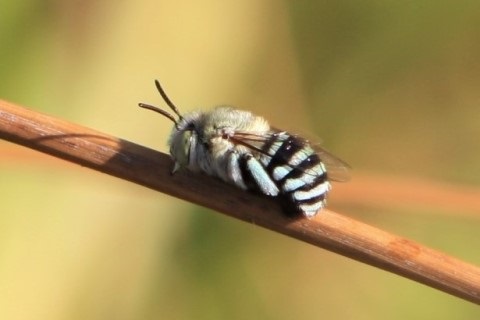Bees in Burnside

Most people recognise European honeybees. These bees were introduced into Australia around 200 years ago. There are also over 300 species of native bees in South Australia. Both European and native bees pollinate plants, but there are many differences between them. This webpage describes the differences between native bees and European honeybees. There is more information about native bees on our Bee Hotel webpage.
European honeybees
European honeybees were introduced to Australia to produce honey and pollinate crops. These bees are kept by beekeepers in artificial hives. They have also become feral, meaning that they build their own nests and persist without beekeepers. While these feral European honeybees pollinate crops, they also compete with native wildlife for resources. For example, European Honeybees build nests in tree hollows, depriving native animals of places to shelter and breed. This competition for hollows is a problem because many local native animals depend on tree hollows, including Rainbow Lorikeets and Owlet Nightjars.

European honeybees are highly social and may aggressively defend their nests. When they sting, these bees leave behind a barbed stinger with a sac of venom. Care must be taken when removing the stinger, to minimise the volume of venom injected. The Honeybee is the most common cause of allergic reactions to insects in Australia. Most people have a mild reaction and do not require medical attention, but you should seek medical attention if you have a strong reaction to a sting. Further information is available on the Health Direct website.
Council may consider removing feral beehives on public property if they pose a high safety risk. Requests for action can be made online through Action Burnside.
There is some concern about a global decline of European honeybees, but this does not translate to a need for action in Australia. Any decline in European honeybees highlights the need for a greater understanding and support for other pollinators, like native bees.
Native bees
Native bees live in our parks and gardens, where they are very important pollinators. You might not recognise native bees because they do not build big, group nests like European honeybees. So you are not likely to notice a native bee nest and you will not see lots of bees flying in and out. Native bees are typically solitary, so you will not see them in large groups at all. Also, there are many different species of native bees, of many different colours and sizes. Some native bees are only 2 millimetres long, while others are 25 millimetres long. So, while you might recognise the European honeybee, you might not recognise the native bees that are common in local parks and gardens.

Some plants require native bees for efficient pollination. Blue-banded bees are a good example of how this works. These bees look like European honeybees but have attractive blue bands (pictured). When these bees visit flowers, they vibrate at very high speeds to release the pollen. This technique is called buzz pollination. European honeybees cannot do buzz pollination. Some local native plants require the buzz for efficient pollination, like kangaroo apples. Buzz pollination is also critical for food plants, including tomatoes and potatoes. If you grow tomatoes in your garden, you are likely to be receiving pollination services from Blue-banded bees!
Other common native bees are Leafcutter bees and Chequered Cuckoo bees. As their name suggests, leafcutter bees cut semi-circular pieces of leaves to line and seal their small nests. If you find semi-circular holes in leaves, there may be leafcutters nearby. The Chequered cuckoo bee has blue dots over its body. It is called a cuckoo bee because, like a cuckoo bird lays its eggs in the nests of other birds, these bees lay their eggs in the nests of other native bees. The more you learn about native bees, the more fascinating they become!
Native bees do not aggressively defend their nests like European honeybees. So, while it is possible for some native bees to sting, the risk is extremely low. These bees are around us all the time and most people do not realise they exist, because they are not prone to stinging. Further, native bee stings do not have the sac of venom that is delivered with a honeybee sting, so stings are not likely to cause a reaction. However, if you are stung by a native bee you should seek medical attention if you have a strong reaction. Further information is available on the Health Direct website.
Find out more on our Bee Hotel webpage, including information about what you can do for native bees.